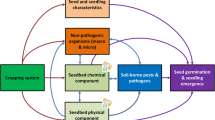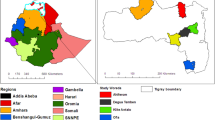Abstract
Holm oak is the hardwood most used for reforestation in Mediterranean Spain, which makes the development of stock quality standards in order to improve establishment success, a priority. However, its nursery culture is characterized by a wide range of practices resulting in stock heterogeneity and a potentially varied outplanting performance. Previous research has focused on specific seedling quality attributes, obviating the integral effect of nursery culture on overall quality. We studied growing regime, seedling quality, and field performance in nine holm oak stocklots produced in commercial nurseries during two consecutive growing years. Results proved variations in field performance were related to stocklot quality and, hence, to the growing regime practised. This dependence on stock quality may vary with planting site weather: in the drier year, survival was related to attributes like height, water status and K concentration, while, in the second, milder year, only growth performance was related to nutrient concentrations, plant size and water status. Results indicated the following quality standards for height: 12–17 cm, diameter: 3.5–4.8 mm, shoot and root weights: 1.3–1.6 and 2.8–4.7 g, respectively, N–P–K foliar concentrations: over 10–0.9–3.7 mg g−1, respectively and in water status parameters: EMX < 5 MPa and SWDTL > 15%. These attributes can be adjusted using nursery cultural practices in order to meet seedling quality standards for holm oak for planting across similar sites.
Resumen
La encina es la frondosa más empleada en España en forestación por lo que el desarrollo de estándares de calidad de planta es una herramienta básica para garantizar el éxito de las plantaciones. Sin embargo, los regímenes de cultivo en vivero son variables originando heterogeneidad en las producciones y una respuesta en campo potencialmente variable. Los estudios previos han estado más centrados en aspectos particulares de calidad que en el efecto integral del régimen de cultivo, por lo que se estudió el cultivo, la calidad y la respuesta de varios lotes comerciales durante dos campañas consecutivas. Los resultados muestran diferencias en la respuesta en función de la calidad y, por tanto, del régimen de cultivo. Las diferencias en supervivencia fueron debidas, el año más seco, a la altura, el estado hídrico o la concentración de K, mientras que el año más húmedo la calidad se relacionó con el crecimiento, siendo la nutrición, el tamaño de planta y los parámetros hídricos los atributos más relacionados. Estos resultados permiten mejorar las técnicas de cultivo en vivero más implicadas en estos atributos, ajustándose así el estándar de calidad para unas condiciones de estación similares a las ensayadas.






Similar content being viewed by others
References
Burdett AN (1983) Quality control in the production of forest planting stock. For Chron 59:133–138
Burdett AN (1987) Understanding root growth capacity: theoretical considerations in assessing planting stock quality by means of root growth test. Can J For Res 17:768–775. doi:10.1139/x87-123
Burdett AN (1990) Physiological processes in plantation establishment and the development of specifications for forest planting stock. Can J For Res 20:415–427. doi:10.1139/x90-059
Canadell J, Vilà M (1992) Variation in tissue element concentrations in Quercus ilex L. over a range of different soils. Vegetatio 99–100:273–282. doi:10.1007/BF00118234
Cherbuy B, Joffre R, Gillon D, Rambal S (2001) Internal remobilization of carbohydrates, lipids, nitrogen and phosphorus in the mediterranean evergreen oak Quercus ilex. Tree Physiol 21:9–17
Chiariello NR, Mooney HA, Williams K (1989) Growth, carbon allocation and cost of plant tissues. In: Pearcy RW et al (eds) Plant physiological ecology. Field methods and instrumentation. Chapman & Hall, London, pp 327–365
Corcuera L, Camarero JJ, Gil-Pelegrín E (2002) Functional groups in Quercus species derived from the analysis of pressure-volume curves. Trees (Berl) 16:465–472. doi:10.1007/s00468-002-0187-1
Correia PJ, Martins-Loução MA (1997) Leaf nutrient variation in mature carob (Ceratonia siliqua) trees in response to irrigation and fertilization. Tree Physiol 17:813–819
Cortina J, Valdecantos A, Seva JP, Vilagrosa A, Bellot J, Vallejo VR (1997) Relación tamaño supervivencia de especies arbustivas y arbóreas mediterráneas producidas en vivero. In: SECF (ed) Proceedings II congreso forestal Español, vol 3. Pamplona, Spain, pp 159–164
Duryea ML (1985) Evaluating seedling quality: importance to reforestation. In: Duryea ML (ed) Evaluating seedling quality: principles, procedures and predictive abilities of major test. Forest Research Laboratory, Oregon State University, Corvallis, pp 1–4
Ericsson T (1995) Nutrients dynamics and requirements of forest crops. N Z J For Res 24(2/3):133–168
Ferran M (2001) SPSS para windows. Análisis estadístico. McGraw-Hill, Madrid
Jenkinson JL, Nelson JA, Huddleston ME (1993) Improving planting stock quality. The Humboldt experience. USDA forest service. Pacific southwest research station. General technical report. PSW-GTR-143
Kozlowski TT, Kramer PJ, Pallardy SG (1991) The physiological ecology of woody plants. Academic Press, New York
Landis TD, Karrfalt RP (1987) Improving seed-use efficiency and seedling quality through the use of history plots. Tree Plant Notes 38(3):9–15
Landis TD, Tinus RW, McDonald SE, Barnett JP (1994) Nursery planning, development and management, vol 1. The Container Tree Nursery Manual. US Department of Agriculture, Forest Service, Washington, DC. Agric Handbk 674
Lloret F, Casanovas C, Peñuelas J (1999) Seedling survival of Mediterranean shrub land species in relation to root:shoot ratio, seed size and water and nitrogen use. Funct Ecol 13:210–216. doi:10.1046/j.1365-2435.1999.00309.x
Lo Gullo MA, Salleo S (1988) Different strategies of drought resistance in three mediterranean sclerophyllous trees growing in the same enviromental conditions. New Phytol 108:267–276. doi:10.1111/j.1469-8137.1988.tb04162.x
López B, Sabaté S, Gracia CA (2001) Fine root longevity of Quercus ilex. New Phytol 151:437–441. doi:10.1046/j.0028-646x.2001.00189.x
McAlister JA, Timmer VR (1998) Nutrient enrichment of white spruce seedlings during nursery culture and initial plantation establishment. Tree Physiol 18:195–202
Navarro G (2000) Química agrícola. Ed. Mundi-Prensa, Madrid
Navarro RM, del Campo A, Alejano R, Alvarez L (1998) Caracterización de calidad final de planta de encina (Quercus ilex L.), alcornoque (Q. suber L.), algarrobo (Ceratonia siliqua L.), acebuche (Olea europeaea L. var. sylvestris), en cinco viveros de Andalucía. Informaciones Técnicas 53/98. CAP, Junta de Andalucía, Sevilla
Ocaña L, Dominguez S, Carrasco I, Peñuelas J, Herrero N (1997) Influencia del tamaño de la semilla y diferentes dosis de fertilización sobre el crecimiento y supervivencia en campo de cuatro especies forestales. In: Proceedings II Congreso Forestal Español, Sociedad Española de Ciencias Forestales, vol 3. Pamplona, Spain pp 461–466
Pallardy SG, Pereira JS, Parker WC (1991) Measuring the state of water in tree systems. In: Lassoie JP, Hinckley TM (eds) Techniques and approaches in forest tree ecophysiology. CRC Press, Boca Raton, pp 27–75
Pardos M, Royo A, Gil L, Pardos JA (2003) Effect of nursery location and outplanting date on field performance of Pinus halepensis and Quercus ilex seedlings. Forestry 76(1):67–81. doi:10.1093/forestry/76.1.67
Pausas JG, Bladé C, Valdecantos A et al (2004) Pines and oaks in the restoration of Mediterranean landscapes of Spain: new perspectives for an old practice—a review. Plant Ecol 171:209–220. doi:10.1023/B:VEGE.0000029381.63336.20
Puttonen P (1997) Looking for the “silver bullet”-can one test do it all? New For 13:9–27. doi:10.1023/A:1006557502326
Ritchie GA (1984) Assessing seedling quality. In: Duryea ML, Landis TD (eds) Forest nursery manual: production of bareroot seedlings. Martinus Nijhoff/Dr. W. Junk publishers, The Hague, pp 243–259
Rose R, Campbell SJ, Landis TD (eds) (1990) Target seedling symposium: proceedings, combined meeting of the western forest nursery associations. USDA forest service, rocky mountain research station. General technical report RM-200
Rubio E, Vilagrosa A, Cortina J, Bellot J (2001) Modificaciones morfológicas en plantones de Pistacia lentiscus y Quercus rotundifolia como consecuencia del endurecimiento hídrico en vivero. Efectos sobre supervivencia y crecimiento en campo. In: Proceedings III Congreso Forestal Español, vol 3. SECF, Granada, Spain pp 527–532
Schulte PJ, Hinckley TM (1985) A comparison of pressure—volume curve data techniques. J Exp Bot 36(171):1590–1602
Stape JL, Moraes Gonçalves JL, Gonçalves AN (2001) Relationship between nursery practices and field performance for Eucalyptus plantations in Brazil. New For 22:19–41. doi:10.1023/A:1012271616115
Steel RGD, Torrie JH (1988) Principles and procedures of statistics. A biometrial approach, 2nd edn. McGraw Hill, New York
Tan W, Hogan GD (1995) Effects of nitrogen limitation on water relations of jack pine (Pinus banksiana Lamb.) seedlings. Plant Cell Environ 18:757–764. doi:10.1111/j.1365-3040.1995.tb00578.x
Thomas FM (2000) Growth and water relations of four deciduous tree species (Fagus sylvatica L., Quercus petraea [Matt.] Liebl., Q. pubescens Willd., Sorbus aria [L.] Cr.) occurring at Central-European tree-line sites on shallow calcareous soils: physiological reactions of seedlings to severe drought. Flora 195:104–115
Valdecantos A (2001) Aplicación de fertilizantes orgánicos en la repoblación de zonas forestales degradadas de la comunidad Valenciana. PhD dissertation. University of Alicante
Valdecantos A, Cortina J, Vallejo VR (2006) Nutrient status and field performance of tree seedlings planted in Mediterranean degraded areas. Ann For Sci 63:249–256. doi:10.1051/forest:2006003
van den Driessche R (1992) Changes in drought resistance and root growth capacity of container seedlings in response to nursery drought, nitrogen, and potassium treatments. Can J For Res 22:740–749. doi:10.1139/x92-100
Vilagrosa A, Seva JP, Valdecantos A (1997) Plantaciones para la restauración forestal en la comunidad Valenciana. In: Vallejo VR et al (eds) La restauración de la cubierta vegetal en la Comunidad Valenciana. CEAM, Valencia, pp 435–556
Villar-Salvador P, Planelles R, Enríquez E, Peñuelas-Rubira J (2004) Nursery cultivation regimes, plant functional attributes and field performance relationships in the Mediterranean oak Quecus ilex L. For Ecol Manage 196:257–266. doi:10.1016/j.foreco.2004.02.061
Wenny DL, Dumroese RK (1992) A growing regime for container-grown Douglas-fir seedlings. Idaho forest, wildlife and range exp station. Bull 49. Univ of Idaho, Moscow
Zine el Abidine A, Bernier PY, Plamondon AP (1994) Water relations parameters for lowland and upland black spruce: seasonal variations and ecotypic differences. Can J For Res 24:587–593. doi:10.1139/x94-077
Acknowledgments
This study has been supported by funds from the Ministry of Agriculture and the project INIA-CICYT “Definición del ciclo de producción de cuatro especies forestales (Quercus ilex L.; Pinus pinea L.; Ceratonia siliqua L. y Olea europaea L. subsp. sylvestris) de especial importancia en los programas de forestación en tierras agrarias en Andalucía (FO96-006)”. We also wish to acknowledge the interest of the participating nurseries. We appreciated comments on the draft manuscript from Sue Morrison of the Forest Research Nursery, University of Idaho.
Author information
Authors and Affiliations
Corresponding author
Rights and permissions
About this article
Cite this article
del Campo, A.D., Navarro, R.M. & Ceacero, C.J. Seedling quality and field performance of commercial stocklots of containerized holm oak (Quercus ilex) in Mediterranean Spain: an approach for establishing a quality standard. New Forests 39, 19–37 (2010). https://doi.org/10.1007/s11056-009-9152-9
Received:
Accepted:
Published:
Issue Date:
DOI: https://doi.org/10.1007/s11056-009-9152-9




